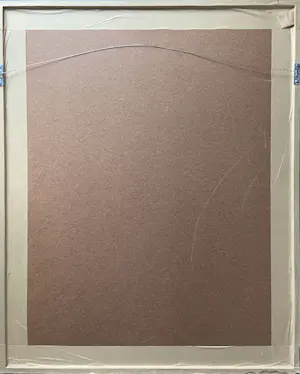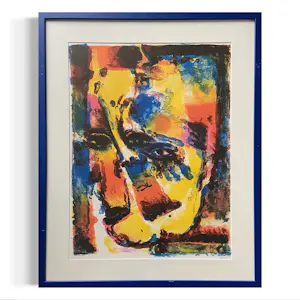Atila Biro - Abstract composition
- Description
- Atila Biro (1931-1987)
| Type of artwork | Prints (signed) |
| Period | 1945 to 1999 |
| Technique | Lithograph |
| Support | Handmade Paper |
| Style | Abstract |
| Subject | Abstract |
| Framed | Framed |
| Dimensions | 73 x 53 cm (h x w) |
| Incl. frame | 90 x 73 cm (h x w) |
| Signed | Hand signed |
| Edition | 150 |
Translated with Google Translate. Original text show .
A beautiful color lithograph by Atila Biro, abstract composition. Numbered 76/150 and signed in pencil.
Total dimensions; 90 x 73 cm.
Atila Biro, born Attila Bíró on 20 February 1931 in Budapest and died on 22 March 1987 in Boulogne-sur-Mer, was a Hungarian architect, painter, etcher and lithographer, naturalized French and signed his works Atila.
Biography
Attila Bíró left Budapest with her family, whose father was an architect, at the end of the Second World War, before the arrival of the Red Army (1944) and settled for a time in Austria, then in 1947 in Saarbrücken, then under French protectorate. The young Attila continued his studies at the Lycée français in this city and then, with the intention of becoming a painter, went to Paris, where in 1951 he began his architectural studies at the École des beaux-arts de Paris (Pousson's workshop). In 1953, however, he went to the Higher Technical School of Stuttgart, where he attended the courses of the architect Günter Behnisch. At the same time, he took painting lessons with Willi Baumeister[4]. He also belonged to philosophical and aesthetic circles around Max Bense[5], and finally attended the art history seminars of Hans Wentzel.
Thanks to his friendship with Georg Karl Pfahler, he participated in the creation of the "Group of Eleven", which included Friedrich Sieber and Günther Kirchberger. The group's first exhibition was held in 1957 at Gallery 17 in Munich. It was soon followed by others in London (New Vision Center Gallery), Brussels (Galerie Les Contemporains), Rome (Galleria La Tartaruga) and again in London (Drian Gallery). Attila Bíró completed his studies in Stuttgart in 1958 with a degree in engineering and architecture. He then moved to Paris and worked in various architectural firms until he was able to earn a living from his painting and devote himself to it. It was through the meeting in 1959 of the American painters of informal abstraction Paul Jenkins and Sam Francis that he found the path that would remain his own, that of a free figuration structured by the chromaticism of the rainbow. It was then that he adopted the artist name Atila, or Atila Biro, his pseudonym which therefore consisted of simply removing the second letter "t" from his first name.
With his wife Lila Lakshmanan (wedding in 1963), a film professional (we owe him the editing of films by Jean-Luc Godard such as Le mépris and Les Carabiniers, François Truffaut such as La peau douce), he divides his working time between his workshop in Nanterre and the edge of the lake. Annotations on the back of watercolors reflect that he liked to find inspiration as far away as Italy. Atila and Lila also made a trip to Morocco, several others to Northern India.
Atila was also interested in lithography and etching, the number of copper engravings he made in Nanterre being estimated at around a hundred works spread over two key periods, 1964-1965 and 1980-1981.
He exhibited his works in solo exhibitions in Paris, Rotterdam, Zurich, Stuttgart, Brussels, Gothenburg and Amsterdam, etc. In 1970 he obtained French nationality. From 1958 to 1973 he participated in projects for the business district La Défense near Paris. About twenty museums have acquired his works.
Total dimensions; 90 x 73 cm.
Atila Biro, born Attila Bíró on 20 February 1931 in Budapest and died on 22 March 1987 in Boulogne-sur-Mer, was a Hungarian architect, painter, etcher and lithographer, naturalized French and signed his works Atila.
Biography
Attila Bíró left Budapest with her family, whose father was an architect, at the end of the Second World War, before the arrival of the Red Army (1944) and settled for a time in Austria, then in 1947 in Saarbrücken, then under French protectorate. The young Attila continued his studies at the Lycée français in this city and then, with the intention of becoming a painter, went to Paris, where in 1951 he began his architectural studies at the École des beaux-arts de Paris (Pousson's workshop). In 1953, however, he went to the Higher Technical School of Stuttgart, where he attended the courses of the architect Günter Behnisch. At the same time, he took painting lessons with Willi Baumeister[4]. He also belonged to philosophical and aesthetic circles around Max Bense[5], and finally attended the art history seminars of Hans Wentzel.
Thanks to his friendship with Georg Karl Pfahler, he participated in the creation of the "Group of Eleven", which included Friedrich Sieber and Günther Kirchberger. The group's first exhibition was held in 1957 at Gallery 17 in Munich. It was soon followed by others in London (New Vision Center Gallery), Brussels (Galerie Les Contemporains), Rome (Galleria La Tartaruga) and again in London (Drian Gallery). Attila Bíró completed his studies in Stuttgart in 1958 with a degree in engineering and architecture. He then moved to Paris and worked in various architectural firms until he was able to earn a living from his painting and devote himself to it. It was through the meeting in 1959 of the American painters of informal abstraction Paul Jenkins and Sam Francis that he found the path that would remain his own, that of a free figuration structured by the chromaticism of the rainbow. It was then that he adopted the artist name Atila, or Atila Biro, his pseudonym which therefore consisted of simply removing the second letter "t" from his first name.
With his wife Lila Lakshmanan (wedding in 1963), a film professional (we owe him the editing of films by Jean-Luc Godard such as Le mépris and Les Carabiniers, François Truffaut such as La peau douce), he divides his working time between his workshop in Nanterre and the edge of the lake. Annotations on the back of watercolors reflect that he liked to find inspiration as far away as Italy. Atila and Lila also made a trip to Morocco, several others to Northern India.
Atila was also interested in lithography and etching, the number of copper engravings he made in Nanterre being estimated at around a hundred works spread over two key periods, 1964-1965 and 1980-1981.
He exhibited his works in solo exhibitions in Paris, Rotterdam, Zurich, Stuttgart, Brussels, Gothenburg and Amsterdam, etc. In 1970 he obtained French nationality. From 1958 to 1973 he participated in projects for the business district La Défense near Paris. About twenty museums have acquired his works.
| Condition | |
| Condition | Very good |
| Shipment | |
| Pick up | The work can be picked up on location. As a buyer you must bring your own packaging materials. The location is: Oudenaarde, Belgium |
| courier-service | If you are unable to collect a work yourself, you can engage a courier service to have the work collected. Click here for more information about how this works and view the rates. |
| Shipment | Due to its size or fragility, it is not possible to send this item via regular mail |
| Guarantee | |
| Guarantee | By putting the item up for auction, I agree with the Terms of Guarantee as they are applicable at Kunstveiling regarding the accuracy of the description of the item |
The seller takes full responsibility for this item. Kunstveiling only provides the platform to facilitate this transaction, which has to be settled directly with the seller. More information .





 French
French  Hungarian
Hungarian